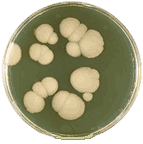Papers in the Biological Sciences
Document Type
Article
Date of this Version
11-2011
Citation
EUKARYOTIC CELL, Vol. 10, No. 11, Nov. 2011, pp. 1448–1454. doi:10.1128/EC.05196-11
Abstract
Biofilms of Candida albicans include both yeast cells and hyphae. Prior studies indicated that a zap1/ mutant, defective in zinc regulator Zap1, has increased accumulation of yeast cells in biofilms. This altered yeast-hypha balance may arise from internal regulatory alterations or from an effect on the production of diffusible quorum-sensing (QS) molecules. Here, we develop biosensor reporter strains that express yeastspecific YWP1-RFP or hypha-specific HWP1-RFP, along with a constitutive TDH3-GFP normalization standard. Seeding these biosensor strains into biofilms allows a biological activity assay of the surrounding biofilm milieu. A zap1/ biofilm induces the yeast-specific YWP1-RFP reporter in a wild-type biosensor strain, as determined by both quantitative reverse transcription-PCR (qRT-PCR) gene expression measurements and confocal microscopy. Remediation of the zap1/ zinc uptake defect through zinc transporter gene ZRT2 overexpression reverses induction of the yeast-specific YWP1-RFP reporter. Gas chromatography-mass spectrometry (GC-MS) measurements of known organic QS molecules show that the zap1/ mutant accumulates significantly less farnesol than wild-type or complemented strains and that ZRT2 overexpression does not affect farnesol accumulation. Farnesol is a well-characterized inhibitor of hypha formation; hence, a reduction in farnesol levels in zap1/ biofilms is unexpected. Our findings argue that a Zap1- and zinc-dependent signal affects the yeast-hypha balance and that it is operative in the low-farnesol environment of the zap1/ biofilm. In addition, our results indicate that Zap1 is a positive regulator of farnesol accumulation.
Included in
Environmental Microbiology and Microbial Ecology Commons, Other Life Sciences Commons, Pathogenic Microbiology Commons



Comments
Copyright © 2011, American Society for Microbiology. Used by permission.